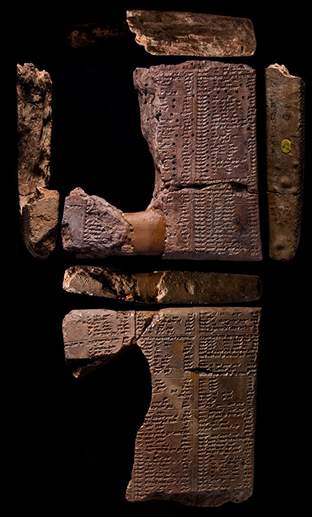Eponym lists and chronicles
The Assyrians did not count years but named them after the king, high officials and provincial governors - the year eponyms TT , as we call them, using a Greek term referring to the same practice as attested in e.g. ancient Athens. The year names are collected in the Assyrian eponym lists and chronicles, copies of which were excavated in Nineveh, Assur and Šibaniba (modern Sultantepe near Urfa). Nine manuscripts list just the year names (the 'eponym lists') while twelve others give the names with historical information (the 'eponym chronicles').
Alan Millard has edited these texts in the State Archives of Assyria Studies series. The editions of the individual manuscripts as well as the composite text are reproduced here with the kind permission of the author and the Neo-Assyrian Text Corpus Project [http://www.helsinki.fi/science/saa/] (NATCP). Copyright remains with the author and the NATCP. The texts may not be reproduced for non-educational purposes, beyond fair use, without the permission of the author and the NATCP.
» Browse or search the eponym lists and chronicles. [http://oracc.museum.upenn.edu/saao/saas2/corpus]
| Abbreviation | Original publication |
|---|---|
| SAAS 2 | A. R. Millard, The Eponyms of the Assyrian Empire 910-612 B.C. (State Archives of Assyria Studies 2), Helsinki 1994 |
A useful introduction to the nature and function of the eponym lists and chronicles can be found in Millard, A. R., 'Observations from the Eponym Lists', in S. Parpola and R. M. Whiting (eds.), Assyria 1995, Helsinki: Neo-Assyrian Text Corpus Project, 1997, 207-215. Download PDF version of article (984 KB) [~/downloads/millard_assyria_1995_1997.pdf] (requires free Adobe Acrobat reader [http://www.adobe.com/uk/products/acrobat/readstep2.html]).
The original publication was reviewed in a number of specialist journals:

- Brinkman, J. A., in Journal of Near Eastern Studies 58 (1999), 53-54. View article on JSTOR (requires subscription) [http://www.jstor.org/stable/545719].
- Edzard, D. O., in Zeitschrift für Assyriologie und vorderasiatische Archäologie 89 (1999), 296-297. View article online (requires subscription) [http://dx.doi.org/10.1515/zava.1999.89.2.283].
- Finkel, I. L. and J. E. Reade, 'Assyrian Eponyms, 873-649 BC', Orientalia 67 (1998), 248-254. Download PDF version of article (2.2 MB) [~/downloads/finkel_reade_or_67_1998.pdf] (requires free Adobe Acrobat reader [http://www.adobe.com/uk/products/acrobat/readstep2.html]).
- Finkel, I. L. and J. E. Reade, 'Lots of Eponyms', Iraq 57 (1995), 167-172. Download PDF version of article (2.1 MB) [~/downloads/finkel_reade_iraq_57_1995.pdf] (requires free Adobe Acrobat reader [http://www.adobe.com/uk/products/acrobat/readstep2.html]).
- Freydank, H., in Orientalistische Literaturzeitung 90 (1995), 511-514.
- Lambert, W. G., in Book List: The Society for Old Testament Study (1995), 135.
- Mitchell, T. C., in Bulletin of the American Society for Oriental Research 297 (1995), 93-94. View article on JSTOR (requires subscription) [http://www.jstor.org/stable/1357398].
- Reade, J. E., 'Assyrian eponyms, kings and pretenders, 648-605', Orientalia 67 (1998), 255-265. Download PDF version of article (1.3 MB) [~/downloads/reade_or_67_1998.pdf] (requires free Adobe Acrobat reader [http://www.adobe.com/uk/products/acrobat/readstep2.html]).
- Schramm, W., in Orientalia 67 (1998), 280-284.
- Zawadzki, S., in Rosznik Orientalistizny 51/1 (1998), 185-190.
The online edition incorporates the collations and the additional manuscript B12 offered by I. L. Finkel and J. E. Reade in their review article 'Assyrian Eponyms, 873-649 BC' (see above). Other than that, we have not taken the reviews into account in the online edition but strongly recommend that they be consulted when using this site as a resource for specialist Assyriological research.
If your browser has problems displaying all the special transliteration characters, you may want to download Steve Tinney's Ungkam font [http://oracc.museum.upenn.edu/doc/user/fonts/#Ungkam] for Mac, Windows or Linux.
If you're still having trouble viewing these characters, then you'll need to set the character encoding on your browser correctly.
- On Firefox, go to the Character Encoding item on the View menu and choose Unicode (UTF-8).
- On Google Chrome, go to the Encoding item on the View menu and choose Unicode (UTF-8).
- On Internet Explorer, go to the Encoding item on the View menu and choose Unicode (UTF-8).
- On Safari, go to the Text Encoding item on the View menu and choose Unicode (UTF-8).
Content last modified: 12 Mar 2013.